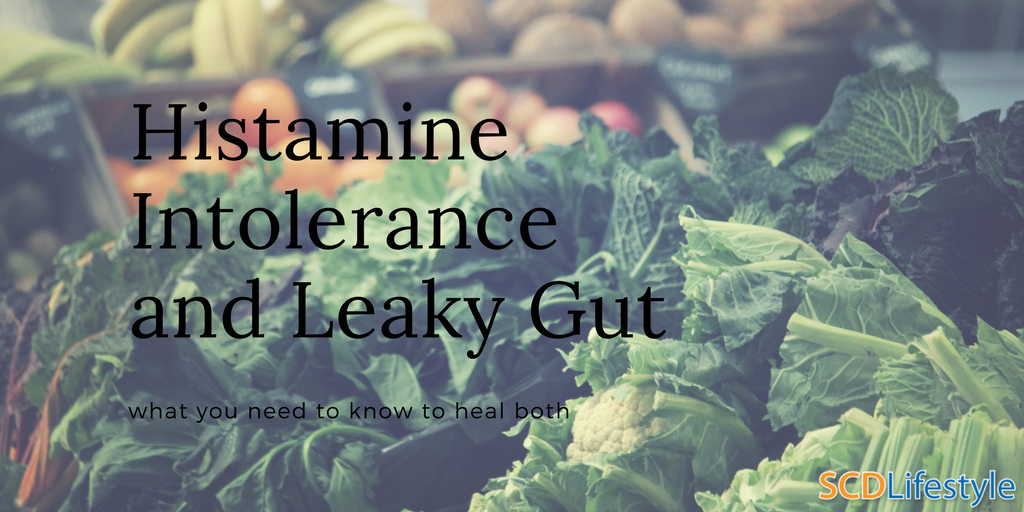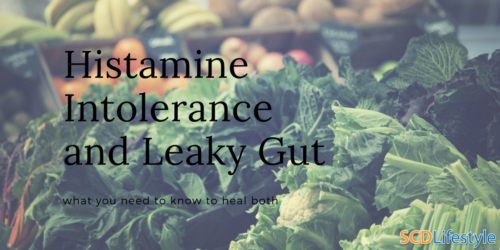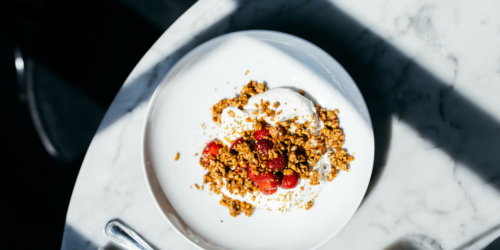Histamine Intolerance: 8 Causes, Symptom Checklist, And Get Relief Today


Few things are more frustrating than switching to a healthy diet and feeling WORSE.
For those with histamine intolerance, this is often the case.
That’s right – gut-healthy favorites like fermented foods, probiotic supplements, and leftover grass-fed meat can actually make you feel worse.
And because histamines can affect the entire body, it’s often misdiagnosed. (You’ll likely be told it’s “just” allergies or IBS)
If you have dozens of random symptoms that appear out of nowhere, this is one condition you can’t afford to overlook.
Headaches, brain fog, chronic nasal congestion, bloating, restless leg – yep, those are all signs of histamine intolerance.
In this blog post, we cover everything you need to know about conquering a histamine intolerance so you can start living again.
What Are Histamines?
Histamine is a naturally occurring chemical that plays a role in our immune and neurological systems. It serves as a neurotransmitter, where it sends messages from the body to the brain, and helps regulate our stomach acid (Hydrochloric acid or HCL) so we can digest food.
Most notably, histamines are associated with allergies to pets or ragweed and anaphylaxis shock. The curious thing is how important the right levels of them are for normal body functions..
Histamines perform many functions by binding to receptor sites, which are located all over the body. (This is why histamine symptoms are so widespread.)
Histamine receptors and functions include:
- H1 receptors: Located all over the body; cause vessels to vasodilate
- H2 receptors: Located in the stomach; signals the release of stomach acid, increases heart rate
- H3 receptors: Located in the brain; regulates nerves, sleep/wake cycle, and appetite
- H4 receptors: Located in the small intestine and colon; play a role in the body’s inflammatory response
As you can see histamines play an important role in our health. Issues arise in the histamine system when these molecules aren’t degraded or broken down properly. This process is what’s commonly called Histamine intolerance.
What Is A Histamine Intolerance?
When histamines are generated faster than they can be degraded, an intolerance can develop.
In healthy individuals, histamines are primarily broken down by the N-methyltransferase (HMT) enzyme in the central nervous system and the diamine oxidase enzyme (DAO) in the gut.
The DAO enzyme, also known as histaminase, is the primary enzyme responsible for degrading ingested histamines. If it’s unable to do its job, excess histamines are absorbed into the blood where they can cause a wide variety of symptoms.
The most common signs and symptoms of histamine intolerance are:
- Headaches
- Itching and hives
- Flushing of the face and neck area
- Accelerated heart rate
- Anxiety and/or panic attacks
- Dry mouth/increased need for fluids
- Nasal congestion and sneezing
- Fatigue
- Dizziness or vertigo
- Tissue swelling
- Difficulty sleeping
- Irregular menstrual cycles
- Low blood pressure
Think of your body like a cup – if the accumulated amount of histamines surpasses the body’s ability to break it down, the cup will overflow.
And this is when all those random symptoms start to show up.
Where Do Histamines Come From?
Histamines are produced by the gut (more on this later) and are also found in the food we eat.
It’s difficult to quantify the exact amount of histamine in food – which is why you’ll find contradicting information and several different food lists on the internet.
The amount varies greatly according to the type of bacteria, length of time unrefrigerated, and conditions for fermentation.
Below is a list of foods that could potentially contribute to an accumulation of histamines in the body.

Histamine Rich Foods:
- Fermented alcoholic beverages: wine, champagne, and beer (histamine is a byproduct of fermentation)
- Fermented foods: sauerkraut, vinegar, soy sauce, kefir, yogurt, kombucha
- Vinegar-containing foods: pickles, mayonnaise, olives
- Soured foods: sour cream, sourdough bread
- Cured meats: bacon, salami, pepperoni, lunch meat, and hot dogs
- Smoked fish and certain species of fish: mackerel, mahi-mahi, tuna, anchovies, sardines
- Dried fruit: apricots, prunes, dates, figs, raisins
- Most citrus fruits
- Aged cheese
- Nuts (especially peanuts and walnuts) and nut butters
- Vegetables: avocados, eggplant, spinach, and tomatoes
- Leftover meat (contains high levels of the amino acid histidine which is converted to histamine by naturally occurring bacteria)
Histamine Releasing Foods (These foods don’t contain histidine themselves, but can cause mast cells to release histamines):
- Alcohol
- Bananas
- Chocolate
- Cow’s Milk
- Nuts
- Papaya
- Pineapple
- Shellfish
- Strawberries
- Tomatoes
- Many artificial preservatives and dyes
Histamine Enzyme Blockers (Foods that block DAO – increasing system levels):
- Alcohol
- Energy drinks
- Tea – Black, mate and green varieties
An intolerance to one or many of these foods doesn’t mean that particular food is bad, but rather an indicator of something bigger.
The 8 Causes of Histamine Intolerance?
Generally speaking, a histamine intolerance results from the overproduction of histamines and/or the inability to break them down. However, several factors play a role in how that occurs.
Some of the most common underlying causes of histamine intolerance are:
Leaky Gut – A leaky gut allows large, undigested food particles to seep into the bloodstream – which alarms the immune system to release histamine in response to the threat. Furthermore, intestinal inflammation will decrease the ability of the DAO enzyme to break down histamines in the gut, contributing to an overload.
Free Leaky Gut Quiz: Take this 3-minute quiz to see if you’re at risk for a leaky gut.
Non Steroidal Anti-Inflammatory Drugs (NSAIDs) – Foods aren’t the only way of filling up your histamine bucket. These common anti-inflammatories contribute to inflammation in the gut, which can further suppress DAO production. Studies show aspirin, specifically, can play a role in the release of histamine from mast cells.
Candida Overgrowth – Fungal infections and histamine intolerance have a strong connection. Candida, a “normal” member of the microbiome, can take over if given the opportunity. In the case of a Candida overgrowth, histamines are released in an effort to kill the fungus.
Gut Bacteria – The bacteria in our gut have the ability to produce or degrade histamines as well as remain neutral. Lactobacillus reuteri (ATCC PTA 6475), Streptococcus thermophilus, Lactobacillus casei, and various strains of E. coli are known to produce histamines. When histamine producing strains outweigh histamine degrading strains (i.e gut dysbiosis), symptoms can start to surface.
Small Intestine Bacterial Overgrowth (SIBO) – Histamine is formed when bacteria in the gut break down the amino acid histidine, which is why an overgrowth could increase the production of histamine in the body. SIBO also causes inflammation in the gut, which can contribute to lower production of DAO enzymes. One of the biggest risk factors for SIBO is low stomach acid.
Irritable Bowel Syndrome (IBS) – In a recent study, 58% of patients with IBS experienced GI symptoms from histamine-releasing foods. IBS patients have an increased number of mucosal mast cells (which release histamine) in the rectum, colon, ileum and jejunum as compared to those without IBS. A recent study revealed the FODMAP diet “may significantly improve IBS symptoms” by reducing histamines in the gut (as compared to those not on the diet).
Genetics – Genetic variants of the AOC1/ABP1 gene and/or the HNMT gene can affect the production of diamine oxidase. Methylation issues, which often result from a homozygous MTHFR mutation, can also cause histamine symptoms.
Vitamin and Mineral Deficiencies – Vitamin C and B6, are necessary for the proper function of the DAO enzyme, while a lack of magnesium is associated with decreased DAO activity. Poor dietary habits and a leaky gut are two primary causes of nutritional deficiencies.
How Do I Know If I Have A Histamine Intolerance?
Histamine intolerance manifests in approximately 3% of the population and approximately 80% are women over the age of 40.
As common as it is, most doctors are not familiar with this condition and thus it is overlooked or misdiagnosed. Instead, patients will likely be tested for allergies only to find there aren’t any.
There is no single diagnostic tool to confirm a diagnosis, but an elimination diet is the easiest, most convenient way to know if you’re suffering from histamine intolerance.
(If you eliminate all histamine foods for 30 days and feel better… there’s your diagnosis.)
If you want to utilize testing measures, the 23andMe home-based genetic test looks at the genes associated with DAO enzyme production. If you’re homozygous for MAO (monoamine oxidase) enzyme, there’s a chance histamines will be a problem for you.
You can also ask your doctor to run a DAO serum test, which measures DAO activity and is a useful tool in diagnosing a histamine intolerance.
And if antihistamine medications are something you frequently rely on, it could also be a sign that histamines are an issue for you. And while antihistamines may provide immediate relief of symptoms, they aren’t a long term-solution (Benadryl is linked to Dementia).
The Dangerous Problem of Antihistamines
With a name like antihistamines, it’s no wonder medications like Allegra and Zyrtec are part of a billion-dollar industry.
Antihistamine medications are designed to stop histamines from binding to histamine receptors – primarily the H1 and H2 receptor sites.
But antihistamine medications don’t remove histamines from the body – which means they’re free to bind to remaining receptors. This explains why Benadryl can relieve a runny nose and itchy eyes but is ineffective for headaches, dizziness, or other common histamine symptoms.
Antihistamine medications only deal with the result – not the cause.
(Not to mention the long list of side effects that accompany these over-the-counter medications.)
Furthermore, a number of studies show they can deplete DAO enzyme activity. This is bad news, as our DAO enzymes must be working properly in order to reduce the amount of histamine absorbed into the bloodstream.
As useful as they may be for emergency situations, there are other alternatives that can relieve symptoms as well as support the healing process.
3 Powerful Supplements For Histamine Intolerance
The following supplements can help you overcome a histamine intolerance naturally:
Probiotics – The right probiotics serve a dual purpose – they can help heal the gut and degrade histamines. Bifidobacterium, in particular, can interfere with the histamine pathway and reduce levels of histamine. In one study, B. infantis and B. longum suppressed histamine release, lowered histamine levels and decreased allergy-like symptoms. Other helpful strains include: Lactobacillus rhamnosus and Lactobacillus plantarum.
D-Hist – This product combines 5 powerful nutrients to help calm symptoms and degrade histamines naturally. Quercetin is a bioflavonoid that blocks histamine release from mast cells, while Vitamin C and Bromelain fight histamine symptoms. Research has shown stinging nettles and NAC (N-Acetyl Cysteine) to also have important roles in controlling histamine-induced symptoms.
DAO Enzymes – DAO supplements are most helpful for those who have an issue breaking down histamine as opposed to overproducing it. They help degrade and reduce exogenous (outside) histamine and can be very helpful in some cases. The easiest way to know if a DAO supplement will be helpful is to test it out.
Each of these supplements is most effective when they’re part of a multi-faceted approach including diet and lifestyle changes. Next up – how to change your diet to heal faster.
Adopting A Low Histamine Diet For Quick Symptom Relief

With a long list of histamine foods to avoid, you’re probably wondering what in the world you CAN eat.
Before we jump into a list of low histamine foods, keep this in mind – it’s not about following the right or wrong diet. It’s about following the diet that works for you.
Here’s a general list of foods that are acceptable on a low histamine diet:
- Freshly cooked grass-fed meat, poultry (frozen or fresh)
- Fresh Fish
- Free-range egg yolks (test out the egg whites first before you consume them)
- Gluten-free grains like rice, quinoa, and millet
- Fruits: pear, watermelon, apples, melon, grapes, cherries, blueberries, blackberries
- Fresh vegetables and leafy green (except tomatoes, spinach, and eggplant)
- Coconut milk, rice milk, hemp milk, almond milk
- Ghee, coconut oil, olive oil (Check out our healthy guide to fats.)
- Herbal teas
- Chia, flax, and hemp seeds
- Coconut cream, coconut meat, and coconut butter
Eliminating all potentially problematic foods (for at least 30 days) and adding in low histamine foods is a great way to calm the inflammation and decrease immediate symptoms.
But that will only get you so far.
(Not to mention we don’t want to eliminate these foods indefinitely – high histamine foods are some of the most nutrient-dense, gut-healthy foods on the planet).
The goal in functional medicine is to address the underlying cause – the reason a histamine intolerance is occurring in the first place.
To accomplish this goal, we need to shift our focus to the gut.
How To Overcome A Histamine Intolerance (For Good)
As much as we want to blame histamines, they aren’t the enemy.
Histamines are needed to fight toxins, support the immune system, and are responsible for the first stage in the release of stomach acid.
Histamines only become the enemy when they can’t be broken down or they’re overproduced. Aside from genetics, the most likely cause of either scenario is a leaky gut and infections.
A healthy gut is your most powerful weapon in the fight against histamine intolerance.
But we know healing your gut can be an overwhelming task – and that’s why we want to invite you to join us for a free webinar on “How to Solve Your Leaky Gut and Reverse Chronic Illness.”
It’s completely free, and we walk you through how to address the health of your gut in an easy-to-follow format.
Histamine intolerance is a BIG issue, but it doesn’t have to steal your health.
If you’re having information overload, here’s two important things for you to remember – share this post (it could be life-changing information) and take this leaky gut quiz (click here) to rule it out.
– Steve
Did You Like this Article?
Subscribe to our newsletter to receive email notifications, some ways to find relief, and next steps.

